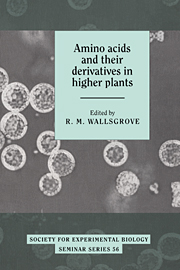Book contents
- Frontmatter
- Contents
- List of contributors
- Preface
- Glutamine synthetase in higher plants: molecular biology meets plant physiology
- Interactions of nitrogen and carbon metabolism: implications of PEP carboxylase and isocitrate dehydrogenase
- The genetics of aspartate derived amino acids in higher plants
- Oxidation of 1-aminocyclopropane-1-carboxylic acid (ACC) in the generation of ethylene by plants
- Regulation of carbon flow through the branched chain amino acid biosynthetic pathway
- Amino acid metabolism and protein deposition in the endosperm of wheat: synthesis of proline via ornithine
- The glycine decarboxylase complex in higher plant mitochondria: structure, function and biogenesis
- Glycine and serine synthesis in non-photosynthetic tissues
- Biogenesis of N-heterocydic amino acids by plants: mechanisms of biological significance
- Toxicity of non-protein amino acids from plants
- Processes involved in glutathione metabolism
- Betaines in higher plants – biosynthesis and role in stress metabolism
- Metabolism and function of polyamines during osmotically induced senescence in oat leaves and protoplasts
- Biosynthesis of cyanogenic glucosides. Elucidation of the pathway and characterization of the cytochromes P-450 involved
- The biosynthesis of glucosinolates in Brassicas
- Biochemical genetics of aliphatic glucosinolates in Brassica and Arabidopsis
- Index
Glycine and serine synthesis in non-photosynthetic tissues
Published online by Cambridge University Press: 09 April 2010
- Frontmatter
- Contents
- List of contributors
- Preface
- Glutamine synthetase in higher plants: molecular biology meets plant physiology
- Interactions of nitrogen and carbon metabolism: implications of PEP carboxylase and isocitrate dehydrogenase
- The genetics of aspartate derived amino acids in higher plants
- Oxidation of 1-aminocyclopropane-1-carboxylic acid (ACC) in the generation of ethylene by plants
- Regulation of carbon flow through the branched chain amino acid biosynthetic pathway
- Amino acid metabolism and protein deposition in the endosperm of wheat: synthesis of proline via ornithine
- The glycine decarboxylase complex in higher plant mitochondria: structure, function and biogenesis
- Glycine and serine synthesis in non-photosynthetic tissues
- Biogenesis of N-heterocydic amino acids by plants: mechanisms of biological significance
- Toxicity of non-protein amino acids from plants
- Processes involved in glutathione metabolism
- Betaines in higher plants – biosynthesis and role in stress metabolism
- Metabolism and function of polyamines during osmotically induced senescence in oat leaves and protoplasts
- Biosynthesis of cyanogenic glucosides. Elucidation of the pathway and characterization of the cytochromes P-450 involved
- The biosynthesis of glucosinolates in Brassicas
- Biochemical genetics of aliphatic glucosinolates in Brassica and Arabidopsis
- Index
Summary
The previous chapter has described the roles that glycine decarboxylase (GDC) and serine hydroxymethyltransferase (SHMT) play in converting photorespiratory-derived glycine to serine, primarily to recover some of the carbon from the glycolate produced by the oxidative reactions of RUBISCO in C3 plants. As well as being needed for protein synthesis, glycine and serine are precursors of a variety of molecules essential to the growth and development of plant tissues. Glycine is required for the synthesis of, amongst other things, glutathione, porphyrins such as leghemoglobin in nitrogen-fixing root nodules, and purines which are needed for nucleic acid synthesis and, in some nodules, for ureide production. Serine plays a similar role as a precursor of biomolecules, including phospholipids, tryptophan and cysteine, and, under some stress conditions is involved in the synthesis of glycinebetaine (see chapter by Gorham, this volume, and Rhodes & Hanson, 1993). The interconversion of glycine and serine, with the concomitant production of methylene tetrahydrofolate, is also important to the plant as a source of one carbon units (see Cossins, 1980). In C3 leaves, photorespiration provides substantial amounts of glycine and serine which can be used for such syntheses. In non-photosynthetic tissue such as roots and developing and germinating seeds, there is a need for glycine and serine just as in the leaves, but there is no photorespiration to produce high levels of glycine and serine. Alternative, nonphotorespiratory routes for the production of glycine and serine exist in such tissues, as well as in the leaves of C3 plants.
- Type
- Chapter
- Information
- Amino Acids and their Derivatives in Higher Plants , pp. 111 - 118Publisher: Cambridge University PressPrint publication year: 1995
- 6
- Cited by

